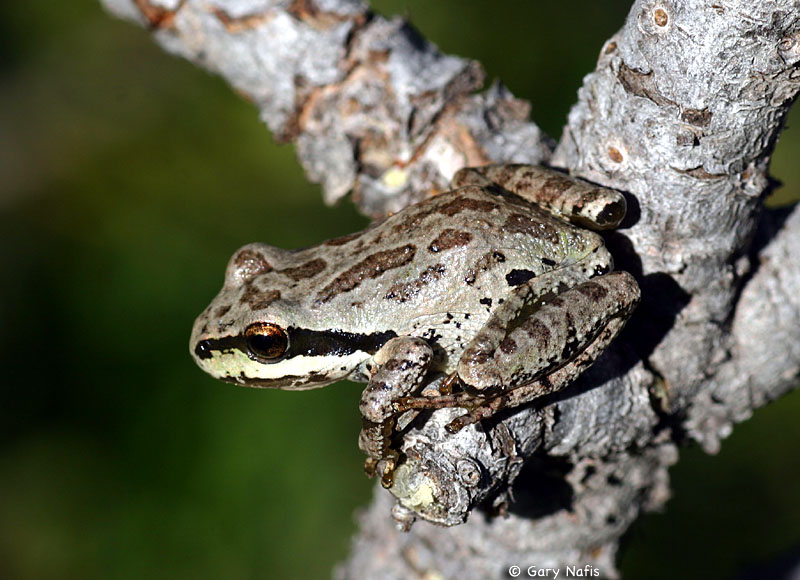Adaptations
The Pacific tree frog has many unique body parts that all have a very specific function. First off, they have a very long, sticky tongue that is used to reach out and grab prey right out of the air. The tongue then retracts quickly into the mouth to allow the frog to eat. (California Herps 2013) To also help with hunting, Pacific tree frogs have sticky toe pads, which enable them to climb on plants and other surfaces while they are sneaking up on prey. They may also wiggle their toes to lure prey into catching range. To learn more about Pacific tree frog prey, check out the Interactions page.
 Pacific
tree frogs, like most frogs, move by jumping with large hind legs.
Their powerful legs allow them to move relatively quickly from place
to place and escape predators if necessary. Their webbed toes,
along with their legs, help them to swim swiftly through the water.
Pacific
tree frogs, like most frogs, move by jumping with large hind legs.
Their powerful legs allow them to move relatively quickly from place
to place and escape predators if necessary. Their webbed toes,
along with their legs, help them to swim swiftly through the water.
Pacific tree frog tadpoles swim through water with a tail, like most other tadpoles. However, the length of the tadpole tail depends on the type of predator in their environment. When tadpoles have bluegill sunfish in their habitat, they develop shorter tails and bodies, which help them to avoid being eaten. To also avoid predation, tadpoles with predaceous diving beetle larvae in their environment develop longer tails and bodies (Benard 2006). Each body style allows the tadpoles to survive in their specific habitat, based off of close predators. To find out more information on tadpoles, visit the Reproduction page.
Pacific tree frogs eat a variety of foods, including large insects. Some of the insects may be as large as they are, in which case they have a problem. To overcome the size issue, the frogs are able to make their bodies slightly larger so that they can eat the insect.
 One
of the most amazing characteristic of the Pacific tree frog is its
ability to exist in different colors based off of the surrounding
environment. Most commonly, the frogs are either green or brown.
The green phenotype usually occurs in cold and aquatic environments
because the green color absorbs more solar radiation. The brown
color doesn’t absorb as much radiation, so that phenotype usually
occurs in dry terrestrial environments. (ADW 2013)
One
of the most amazing characteristic of the Pacific tree frog is its
ability to exist in different colors based off of the surrounding
environment. Most commonly, the frogs are either green or brown.
The green phenotype usually occurs in cold and aquatic environments
because the green color absorbs more solar radiation. The brown
color doesn’t absorb as much radiation, so that phenotype usually
occurs in dry terrestrial environments. (ADW 2013) There are a few other very rare phenotypes, like reddish brown, but
the most recent discovery is the ability for some Pacific tree frogs
to change color. Recent studies show that frogs most likely change
based on the seasons, to match the green background or the lack of
green in the background (Wente and Phillips 2005). The ability to
change colors allows them to blend in with their surrounding and
avoid predation.
There are a few other very rare phenotypes, like reddish brown, but
the most recent discovery is the ability for some Pacific tree frogs
to change color. Recent studies show that frogs most likely change
based on the seasons, to match the green background or the lack of
green in the background (Wente and Phillips 2005). The ability to
change colors allows them to blend in with their surrounding and
avoid predation.
To learn more about the predators of tree frogs, continue on to the Interactions page.
